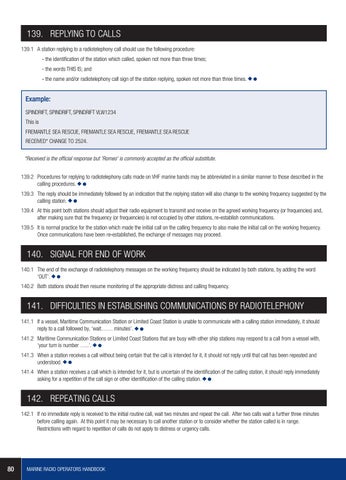139. Replying to Calls 139.1 A station replying to a radiotelephony call should use the following procedure: - the identification of the station which called, spoken not more than three times; - the words THIS IS; and - the name and/or radiotelephony call sign of the station replying, spoken not more than three times.
Example: SPINDRIFT, SPINDRIFT, SPINDRIFT VLw1234 This is FReMANTLe SeA ReSCUe, FReMANTLe SeA ReSCUe, FReMANTLe SeA ReSCUe RECEIVED* CHANGe TO 2524. *Received is the official response but 'Romeo' is commonly accepted as the official substitute. 139.2 Procedures for replying to radiotelephony calls made on VHF marine bands may be abbreviated in a similar manner to those described in the calling procedures. 139.3 The reply should be immediately followed by an indication that the replying station will also change to the working frequency suggested by the calling station. 139.4 At this point both stations should adjust their radio equipment to transmit and receive on the agreed working frequency (or frequencies) and, after making sure that the frequency (or frequencies) is not occupied by other stations, re-establish communications. 139.5 It is normal practice for the station which made the initial call on the calling frequency to also make the initial call on the working frequency. Once communications have been re-established, the exchange of messages may proceed.
140. Signal For End of Work 140.1 The end of the exchange of radiotelephony messages on the working frequency should be indicated by both stations, by adding the word ‘OUT’. 140.2 Both stations should then resume monitoring of the appropriate distress and calling frequency.
141. Difficulties in Establishing Communications by Radiotelephony 141.1 If a vessel, Maritime Communication Station or Limited Coast Station is unable to communicate with a calling station immediately, it should reply to a call followed by, ‘wait…… minutes’. 141.2 Maritime Communication Stations or Limited Coast Stations that are busy with other ship stations may respond to a call from a vessel with, ‘your turn is number …..’. 141.3 When a station receives a call without being certain that the call is intended for it, it should not reply until that call has been repeated and understood. 141.4 When a station receives a call which is intended for it, but is uncertain of the identification of the calling station, it should reply immediately asking for a repetition of the call sign or other identification of the calling station.
ating 142.1 If no immediate reply is received to the initial routine call, wait two minutes and repeat the call. After two calls wait a further three minutes before calling again. At this point it may be necessary to call another station or to consider whether the station called is in range. Restrictions with regard to repetition of calls do not apply to distress or urgency calls.
80
MARINE RADIO OPERATORS HANDBOOK
